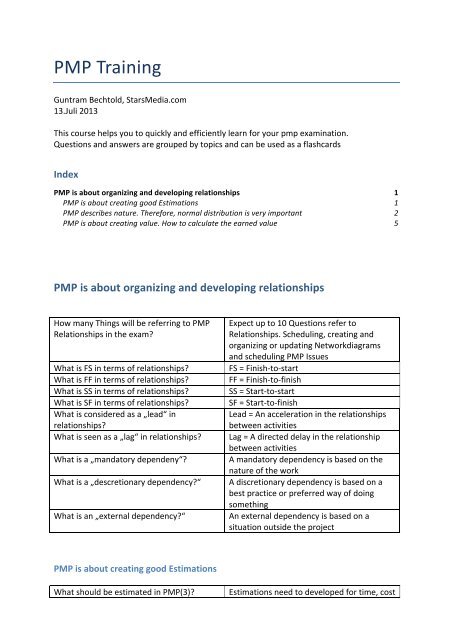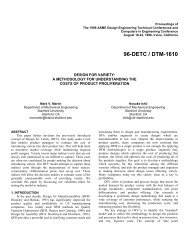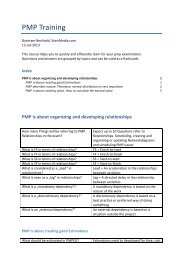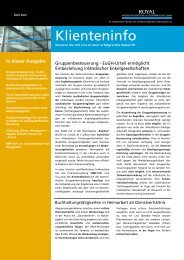PMP Training
You also want an ePaper? Increase the reach of your titles
YUMPU automatically turns print PDFs into web optimized ePapers that Google loves.
<strong>PMP</strong> <strong>Training</strong><br />
Guntram Bechtold, StarsMedia.com<br />
13.Juli 2013<br />
This course helps you to quickly and efficiently learn for your pmp examination.<br />
Questions and answers are grouped by topics and can be used as a flashcards<br />
Index<br />
<strong>PMP</strong> is about organizing and developing relationships 1<br />
<strong>PMP</strong> is about creating good Estimations 1<br />
<strong>PMP</strong> describes nature. Therefore, normal distribution is very important 2<br />
<strong>PMP</strong> is about creating value. How to calculate the earned value 5<br />
<strong>PMP</strong> is about organizing and developing relationships<br />
How many Things will be referring to <strong>PMP</strong><br />
Relationships in the exam?<br />
Expect up to 10 Questions refer to<br />
Relationships. Scheduling, creating and<br />
organizing or updating Networkdiagrams<br />
and scheduling <strong>PMP</strong> Issues<br />
What is FS in terms of relationships? FS = Finish-‐to-‐start<br />
What is FF in terms of relationships? FF = Finish-‐to-‐finish<br />
What is SS in terms of relationships? SS = Start-‐to-‐start<br />
What is SF in terms of relationships? SF = Start-‐to-‐finish<br />
What is considered as a „lead“ in<br />
Lead = An acceleration in the relationships<br />
relationships?<br />
between activities<br />
What is seen as a „lag“ in relationships? Lag = A directed delay in the relationship<br />
between activities<br />
What is a „mandatory dependeny“? A mandatory dependency is based on the<br />
nature of the work<br />
What is a „descretionary dependency?“ A discretionary dependency is based on a<br />
best practice or preferred way of doing<br />
something<br />
What is an „external dependency?“ An external dependency is based on a<br />
situation outside the project<br />
<strong>PMP</strong> is about creating good Estimations<br />
What should be estimated in <strong>PMP</strong>(3)? Estimations need to developed for time, cost
What aspects need to be estimated (4)? and labor aspects. Specifically ressources,<br />
effort duration and costs.<br />
What estimation techniques are known to 1. Analogous Estimation<br />
<strong>PMP</strong>(4)?<br />
2. Parametric Estimation<br />
3. Three point Estimation<br />
4. Bottom up Estimation<br />
What is known as „Analogous“ Estimation? Comparing to existing Projects ist analogous<br />
When used? How accurate?<br />
estimation. Typically used at the beginning.<br />
Its not very accurate<br />
What is known as „Parametric“ Estimation? Its is estimating with Math. Dollars by<br />
Example? Downside?<br />
Squarefoot. Can not be used everywhere.<br />
What is known as „3-‐Point-‐Estimation“? Expert-‐Judgement is abstracted into a 3<br />
How is it created? Formula?<br />
Point estimation. 3 Cases are calculated:<br />
Best-‐Cased, Most-‐Likely, Worst-‐Case. The<br />
„Most-‐Likely“-‐Case is weight 4x more than<br />
optimistic and pessimistic. The therefor<br />
equation is (O+4M+P)/6<br />
What is known as „Bottom-‐Up“ Estimation? Doing the whole work virtually. Breaking<br />
every Task into small, detailed workpackages<br />
and then re-‐summarizing it into one big<br />
picture is called Bottom-‐Up. Since it is a very<br />
granular technique, it is very precise, but<br />
time consuming and expensive.<br />
<strong>PMP</strong> describes nature. Therefore, normal distribution is very important<br />
Why is <strong>PMP</strong> using normal distribution? <strong>PMP</strong> describes nature. Therefore, normal<br />
distribution is very important. All equations<br />
How many Cases fall into 1 standard<br />
deviation?<br />
How many datapoints fall into 2 standard<br />
deviations?<br />
are based on normal distributions.<br />
68,28% fall into 1 standard deviation<br />
95,46% fall into 2 standard deviations
How many datapoints fall into 3 standard<br />
deviations?<br />
From 0 to – 3 standard deviations, how<br />
many cases are there?<br />
From 0 to – 2 standard deviations, how<br />
many datapoints are there?<br />
From 0 to – 1 standard deviations, how<br />
many datapoints are there?<br />
From 0 to +1 standard deviations, how<br />
many datapoints are there?<br />
From 0 to +2 standard deviations, how many<br />
datapoints are there?<br />
From 0 to +3 standard deviations, how many<br />
data pints are there<br />
99,73% are inside of 3 standard deviations<br />
There are 0,15% of datapoints<br />
There are 2,25% of datapoints<br />
There are 16% of datapoints<br />
There are 84% of datapoints<br />
There are 97,75% of datapoints<br />
There are 99,85% of datapoints<br />
<strong>PMP</strong> is about getting to the goal. Progress is conflict. What ways are there for Conflict<br />
resolution?<br />
What techniques are there for Conflict<br />
resultion (6)?<br />
What technique is „Confronting“ in conflict<br />
resolution? When to choose (3)?<br />
1. Problem solving (Conforntation)<br />
2. Collaboration<br />
3. Comporomising<br />
4. Accomodation, Smoothing<br />
5. Forcing<br />
6. Avoiding/Withdrawal<br />
Solving the conflict is confrontation.<br />
1. Choose if the relationship is<br />
important<br />
2. Choose if you trust the other party<br />
to solve the problem
What is done if „Collaboration“ is chosen for<br />
conflict resolution?<br />
What does „Compromoising“ mean in terms<br />
of conflict resolution (5)?<br />
What is called „Smoothing“ and<br />
„Accomodation“ in conflict resolution(5)?<br />
What is seen as „Forcing“ in conflict<br />
resolution?<br />
What is called „Avoiding“ or „Withdrawal“ in<br />
conflict resolution?<br />
3. Choose if you need a win-‐win<br />
outcome<br />
Generate a Win-‐Win trough Collaboration<br />
1. If you have time and trust<br />
2. If you want the team to learn<br />
3. If there are several views to be<br />
consiedered<br />
4. If you want a multi aspect<br />
consensus<br />
If you want to satisfy both parties<br />
1. If there is a willingness to give and<br />
take<br />
2. If both parties need to win<br />
3. If you can not win<br />
4. If you there is an equal relationship<br />
between both sides<br />
5. When the stakes are moderate to<br />
avoid to fight<br />
Focus on areas of commonsense<br />
1. Focus on common goal<br />
2. Keep harmony<br />
3. When any solution is okay<br />
4. When you will lose anyway<br />
5. When you want to create good will<br />
Create a Win-‐Lose outcome<br />
1. When you are right<br />
2. When in a do-‐or-‐die situation<br />
3. When stakes are high<br />
4. When you need to gain power<br />
5. If the relationship is not important<br />
6. If time is of essence<br />
Withraw and cool off<br />
1. When you can’t win<br />
2. When stakes are low<br />
3. To keep neutrality or reputation<br />
4. If the problem will go away on its<br />
own
<strong>PMP</strong> is about creating value. How to calculate the earned value<br />
Why calculate the earned value in <strong>PMP</strong>? 5-‐10 Questions deal with the matter of<br />
earned value.<br />
1. Determine Cost<br />
2. Schedule variances<br />
3. Schedule indexes<br />
Where to start with variances and indexes? If you need to calculate Variances and<br />
Indexes start with what you have, start with<br />
the Earned Value (EV)<br />
Where to start when looking for information If you want to get information, use Present<br />
on schedule?<br />
value (PV)<br />
Where to start when looking for current When looking for Cost, use Actual Value<br />
Cost?<br />
(AC)<br />
How to calculate variance? For variance use substraction<br />
e.g. Start value = Effective Value -‐ Present<br />
value<br />
How to calculate the Cost variance (CV) Cost Variance (CV) = Earned Value – Actual<br />
Cost<br />
How to calculate index? For Index devide values.<br />
Schedule Performance Index = Earned<br />
Value / Planned Value<br />
How to calculate SPI (Scheduled<br />
Performance index)?<br />
How to calculate the Cost Performance<br />
Index (CPI)?<br />
<strong>PMP</strong> Quality Control Tools<br />
Schedule Performance Index = Earned<br />
Value / Planned Value<br />
Cost Performance Index = Earned Value /<br />
Actual Cost<br />
What is a Cause and effect diagram? Cause and effect diagram. Diagrams that<br />
define the inputs to a process or product in<br />
order to identify potential causes of defects.<br />
What is a Histogram? Histogram. A bar chart showing a<br />
distribution of variables.<br />
What is a run chart? Run chart. Show trends in the variation of a<br />
process over time.<br />
What is a scatter diagram? Scatter diagram. Shows the relationship<br />
between two variables.<br />
What is a control chart? Control Chart. A graphic display of process<br />
data over time and against established<br />
control limits, and that has a centerline that<br />
assists in detecting a trend of plotted values<br />
toward either control limit.
What is a flowchart? Flowcharting. The depiction in a diagram<br />
format of the inputs, process actions, and<br />
outputs of one or more processes within a<br />
system.<br />
What is pareto chart? Pareto Chart. A histogram, ordered by<br />
frequency of occurrence, that shows how<br />
many results were generated by each<br />
identified cause.<br />
What is a inspectiondiagram? Inspection. Examining or measuring to verify<br />
whether an activity, component, product,<br />
result, or service conforms to specified<br />
requirements.

















